How to make an induction heating boiler with your own hands: making a home-made heat generator
People are spoiled by civilization and cannot imagine existence without its benefits. Undoubtedly, heating of buildings belongs to them. Heating systems are constantly being improved and are becoming more efficient and convenient to use.
But this is not enough. Agree, it’s not bad at all for heating equipment to also be economical. And this desire is quite feasible - you can make an induction heating boiler with your own hands. He is able not only to provide the necessary level of heating for the room, but also to spend energy resources very economically.
Moreover, even a novice master will collect such equipment if desired. And how to do it right and what materials will be needed for manufacturing - we will discuss these issues in detail in our article. First we consider the device and the principle of operation of the equipment, as well as the advantages of its use.
The content of the article:
Device and principle of operation of equipment
Before engaging in self-assembly of the induction boiler, it is necessary to understand its structure and principle of operation. And only after understanding these points, you can begin to make homemade products.
How does an induction boiler work?
To understand how induction equipment works, you need to get acquainted with the principle of its action. Therefore, let us recall the school physics course.
When an electric current passes through a conductive material, it releases heat. In this case, the amount of heat received will be directly proportional to the voltage and current strength. This pattern was discovered by Joule and Lenz, in whose honor the physical law is named.
But an electric current can appear in a conductor not only when it is directly connected to a power source. There is another method discovered in the century before last by M. Faraday. This is a non-contact method that does not involve the interaction of a power source with a conductor.
Its essence is that when the parameters of the magnetic field that the conductor crosses change, an EMF or electromotive force appears in it.
This phenomenon has been called electromagnetic induction. That it is used in the operation of the induction boiler. It turns out that if there is an EMF, then there will be an electric current, respectively, there will be heating of the conductor.
In this case, it will be produced in a non-contact manner, using induced currents or as they are also called Foucault currents.
There are two ways to obtain electromagnetic induction. In the first case, to obtain induction, the conductor is rotated or moved inside a constant magnetic field. This method is used in electric generators.
Another way to obtain induction - the conductor remains stationary, while the parameters of the magnetic field in which it is located, namely the direction of the lines of force and intensity, are constantly changing.
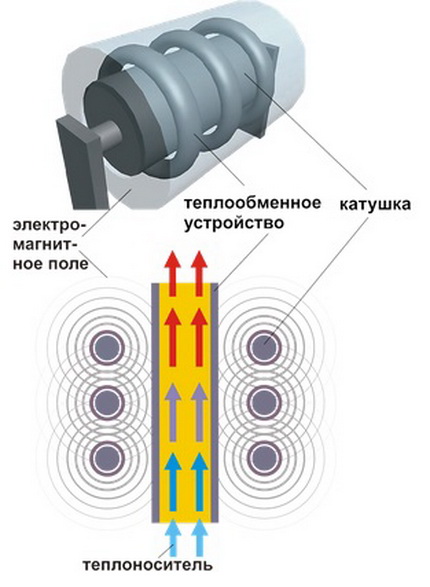
It would be difficult to do this if it were not for the discovery of Oersted. He found out that if you wrap a wire around a coil, then when you connect a power source, it turns into an electromagnet. With a change in direction and current strength, the magnetic field that this device generates will also change.
If a conductor is placed inside the field, an electric current will appear in it, which is accompanied by heating.
It is by this principle that the induction boiler is arranged. Its construction is very simple. It includes a case, necessarily thermally insulated and shielded. A pipe is placed inside it. It is best if it will be alloy, but you can use steel.
True, in the latter case, the operational characteristics of the device will suffer a little. The pipe is installed in a sleeve of dielectric material.
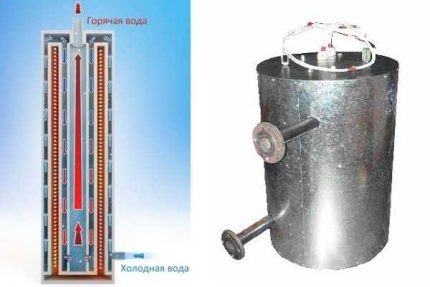
A copper bus is wound on top of the liner according to the coil principle. It is connected to a power source. For connecting to the heating system, two pipes are used, along which the coolant will move.
When power is applied, current flows through the coil and activates an alternating magnetic field, which, in turn, induces eddy currents inside the pipe. They heat the walls of the part, and partially the coolant that is in it.
There are variations of the induction boiler with several tubes of small diameter installed in parallel. They are used instead of one large pipe. This gives a gain in the speed of heating the device.
In this form, the equipment can already work, but the heating will be weak. To strengthen it, you need to pass a high-frequency electric current through the coil. Therefore, the equipment must be supplemented with an inverter and a rectifier.
The alternating current from the network has a frequency of 50 Hz, which is not enough for the efficient operation of the induction boiler. Therefore, it is fed to the rectifier, where it is converted into a constant.
Then it goes to the inverter, which is an electronic module with a control circuit and two key transistors. The device converts direct current to high frequency.
Admittedly, the use of a rectifier and an inverter increases the cost of an induction boiler. Therefore, there are models that work without them. They connect to a regular network. But such equipment has impressive dimensions, which allows to increase its effectiveness. Instruments with an inverter are more compact.
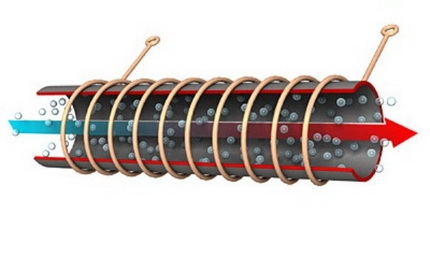
The main elements of heating equipment
Any induction type boiler consists of several structural elements:
- Inductor. The main part of the device. It is a kind of transformer with two windings. The primary is wound around the core. With the passage of current, it is here that an electromagnetic field arises, forming eddy currents. The boiler body acts as a secondary winding. It takes on eddy currents, warms up and transfers thermal energy to the coolant.
- A heating element. This is the core of the coil. For the boiler, it is performed in the form of a pipe of a sufficiently large diameter or several pipes of a smaller cross section connected in parallel.
- Branch pipes. Designed to insert the device into the heating network. One coolant enters the device one by one, and a second liquid exits the boiler and enters the heating circuit.
- Inverter. This device - inverter - Converts a constant electric current to high-frequency, which is then fed to the inductor.
Before proceeding with self-assembly, you should carefully consider what and how the main elements of the device will be made of. Some of them will have to be made by yourself, and some can be bought.
For example, you can use an inverter from a welding machine. Well, if it will be with the ability to adjust power.
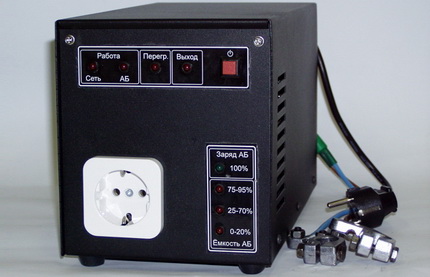
We have listed the main elements of an induction boiler.
Pros of self-assembly of the heater
Electric boilers are traditionally considered uneconomical. Given that the cost of electricity is constantly growing, they cost "a pretty penny" to their owners. We recommend looking at the detailed information on heating from an electric boiler in this article.
However, induction boilers, although powered by electricity, are quite economical.
But this is not the whole list of their advantages.
Having decided to install such a device, you can get:
- Quick heating of the coolant. This takes an average of 3-5 minutes.
- Efficiency close to 100%, since almost all electricity is converted into heat.
- High temperature of heating the liquid in the heating circuit, at least 35 ° C.
- The lack of scale on the internal surfaces of the device, due to vibrations that occur during operation of the device. They prevent deposits.
- Long service life, since there are no moving and rubbing mechanisms and parts. Accordingly, there is no deterioration of equipment and damage to its components.
- No need to divert combustion products and often carry out maintenance activities.
The disadvantages of induction boilers are not so many. First of all, this is a rather high cost of equipment. In addition, in the process, the devices emit a small vibrational noise.
Another disadvantage is the rather large mass, which must be taken into account when mounting the device on the wall.

Assembly instructions for induction boiler
Induction heating appliances can be purchased at the store, but their cost is quite high. Therefore, many home craftsmen try to make it with their own hands. To make a home-made induction boiler, you need to prepare materials and tools.
First you need to purchase a welding inverter. It can be inexpensive, but it is desirable that the device is equipped with a current regulator.
In addition, you should pay attention to the current strength with which the device operates. The standard value for welding inverters is 15A. This will not be enough. Need to look for a more powerful unit.
In addition, you need to prepare a wire rod or wire from stainless steel with a diameter of 7 mm or so. It should be cut into fragments 40-50 mm long. They will be placed in an electromagnetic field, where they will be heated.
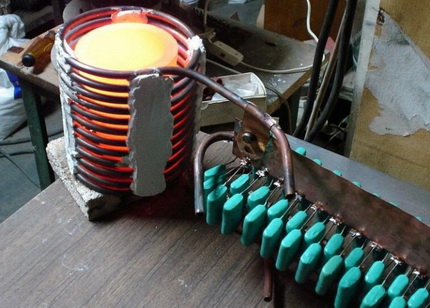
To manufacture the boiler body, a plastic thick-walled pipe is taken. The diameter of the part can vary, but, as practice shows, the best option is 50 mm in inner diameter.
Adapters are used to connect equipment to the heating system. Through one of them, the coolant will enter the boiler, and through the other, the hot fluid will be supplied to the system.
Fragments of the wire should be laid in the casing. So that they do not fall out, the bottom of the part is covered with a fine-mesh metal or nylon mesh, which is securely fixed to the body. After that, you can lay the wire inside the case.
Now the upper part of the part is covered with the same mesh as the bottom, and it is fixed to the walls of the part. Adapters are put on the end. It turns out the workpiece from which the induction coil will be made.
To do this, you need to wind an enameled copper wire on it. On average, 90 turns are required. They should be located closer to the center of the part. You need to perform them very carefully and evenly, so that you get a high-quality induction coil.
The resulting device can be installed in the heating system. This is done as follows. First, the coolant is drained from the system.
After that, the place where the boiler will be installed is selected.The pipe in this section is marked, after which a fragment equal to the length of the heating device is cut out of it.
Then a home-made induction boiler is installed on the prepared place. The coil is connected to the inverter, on this installation can be considered complete. After that, the system again filled with coolant.
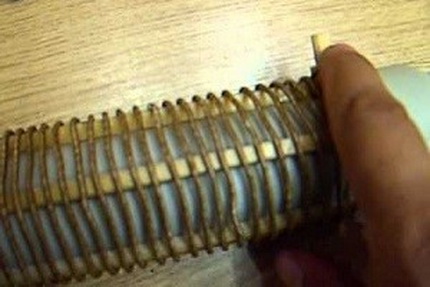
Only then can a new device be tested. It must have liquid in it.
If you turn on the induction boiler “dry”, the plastic case will melt from high temperature. This will lead to a partial destruction of the heating system, which is unacceptable.
Another important point is the competent arrangement of the grounding of the heating device, without which its safe operation is impossible.
Features of the vortex induction boiler
We are already familiar with the principle of operation of an induction heating device. There is a variety of it: a vortex induction boiler or VIN, acting somewhat differently.
Distinctive features of VIN
Like the induction analog, it works from high-frequency voltage, therefore it is necessarily equipped with an inverter. The peculiarity of the VIN device is that it does not have a secondary winding.
Its role is played by all the metal parts of the device. They are necessarily made of materials that exhibit ferromagnetic properties. Thus, when current flows to the primary winding of the device, the electromagnetic field increases sharply.
It in turn generates a current whose strength is rapidly increasing. Eddy currents provoke magnetization reversal, as a result of which all ferromagnetic surfaces very quickly, almost instantly, heat up.
Vortex devices are quite compact, but due to the use of metal, their weight is large. This gives an additional advantage, since all massive elements of the housing take part in heat transfer. Thus, the efficiency of the unit approaches 100%.
This feature of the device must be taken into account if it is decided to independently manufacture a VIN boiler. It can only be made of metal, plastic should not be used.
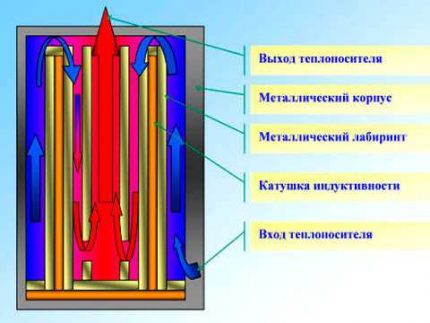
How to assemble a vortex induction device?
As we already know, such a boiler differs from its induction counterpart, however, it is just as easy to make it yourself. True, welding skills will now be needed, because the device should be assembled only from metal parts.
For work you will need:
- Two identical lengths of metal thick-walled pipe. Their diameters must be different, so that one part can be placed in another.
- Winding (enameled) copper wire.
- Three-phase inverter, it is possible from the welding machine, but as powerful as possible.
- Casing for thermal insulation of the boiler.
Now you can get to work. We start with the manufacture of the body of the future boiler. We take a pipe of larger diameter and insert the second part inside. They need to be welded one into another so that a certain distance remains between the walls of the elements.
The resulting sectional detail will resemble a steering wheel. A steel sheet with a thickness of at least 5 mm is used as the base and cover of the case.
As a result, we get a hollow tank of cylindrical shape. Now you need to embed in its walls the pipes under the cold supply pipe and the drain of hot liquid. The configuration of the nozzle and its diameter depend on the pipes of the heating system, you may additionally need adapters.
After that, you can start winding the wire. It is neatly, under sufficient tension, wound around the boiler body.
Actually, the wound wire will serve as the heating element, therefore it is advisable to close the device case with a heat-insulating casing. Thus, it will be possible to maintain maximum heat and, accordingly, increase the efficiency of the device and make it safe.
Now you need to embed the boiler in the heating system. To do this, the coolant is drained, the required length of the pipe section is cut off and the device is welded in its place.
It remains only to power the heater and do not forget to connect an inverter to it. The device is ready for use. But before conducting the tests, you need to fill the line with coolant.
You do not know which coolant to choose to fill the circuit? We recommend that you familiarize yourself with characteristics of various coolants and recommendations for choosing the optimal type of fluid for the heating circuit.
Only after pumping the coolant into the system carry out a test run.
First you need to start the device at minimum power and carefully monitor the quality of the welds. If everything is in order, we increase the power to the maximum.
On our site there is another instruction for the manufacture of an induction device that can be used to heat the coolant in a heating system. To familiarize yourself with the assembly process of an induction heater, go to this link.
Unusual model of induction device
This modification of the induction boiler may seem very unusual, however, it has a right to exist.
Moreover, practice shows that such a device is much more economical than a standard heating element boiler. It will take about 1.8-2.5 kW per hour to heat a standard "three rubles", while an electric boiler will spend at least 6 kW.
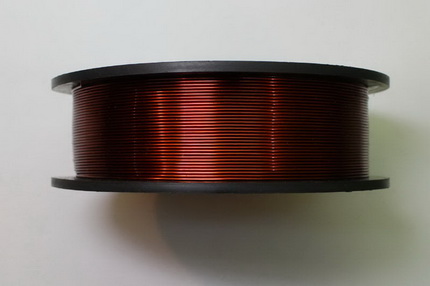
Actually, the boiler is a heat exchanger embedded in the heating system, which is heated by an induction electric stove.
An important part of the design is the heat exchanger; it must be compact, reliable and as cheap as possible. Calculations show that for heating an apartment of about 50 square meters. m will be enough device working with 40 liters of coolant.
That is, you need a flat metal tank, the sizes of which vary within 50x600x500 mm. It is quite possible to make such a container yourself by welding from profile pipes 50x50.
The work is carried out in the following sequence:
- A 50x50 pipe is cut into lengths of 600 mm. In total, it should turn out 9-10 pieces.
- The obtained segments are welded one to another according to the “wall to wall” principle so that a continuous row of pipes is obtained.
- Two more pieces are cut from the pipe so that their length is equal to the width of the resulting workpiece.
- One wall is cut from both fragments obtained.
- The part is installed with the cut part on the pipes welded together so that a workpiece resembling a collector is obtained. The fragment is welded to the heat exchanger.
- Similarly, the second pipe section is installed on the opposite side.
- Pipes are welded into diagonally opposite sections of the heat exchanger for connection to the heating system.
- The structure is thoroughly scalded because it must be completely airtight.
The heat exchanger is ready, it can be installed in place and a heat source placed under it. Practice shows that it is best to install such a system in the bathroom by performing vertical installation.
The heat exchanger is welded into the heating system, and the tile is located between it and the wall.
Home masters argue that if you connect an inverter to such a device, its power consumption will significantly decrease.
After reading the instructions for you, making home-made boilers seems complicated and dangerous? Do you doubt that home-made products will be more economical in consuming electricity to heat the coolant in the heating system? In this case, the purchase of a finished heating unit will be the best solution.
Our site has useful materials for choosing the best electric boiler and a rating of the most popular models among buyers. We also recommend that you familiarize yourself with the features of calculating the energy consumption of the boiler and other options for electric heating in the house:
- Electric boiler for heating a private house: an overview of the top ten models of electric boilers
- How much electricity does an electric boiler consume: calculation rules
- Electric heating in a private house: an overview of the types of systems for a country house
Conclusions and useful video on the topic
How to assemble an induction type boiler yourself:
How does a homemade induction heater work:
What is induction heating:
Induction boiler - the most economical and efficient of all heating appliances powered by electricity. There are many modifications of home-made induction devices, you can choose any one that is most suitable for the operating conditions.
To buy such a device in the store will have to spend a significant amount, so home craftsmen have learned how to make them yourself.
Do you use a home-made induction boiler as a heater? Share your homemade photo and assembly recommendations in the comments section.
Or maybe you are just going to start manufacturing the boiler and you still have unresolved questions after reading our article? Feel free to ask them - we will try to help you.

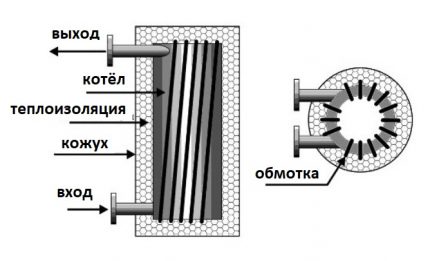
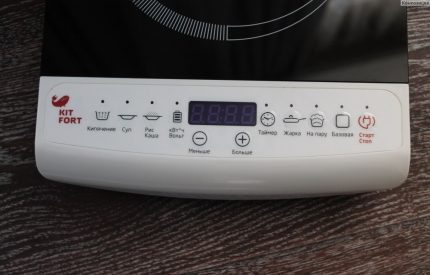
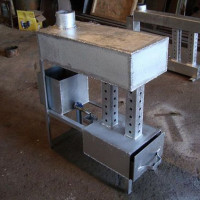 Do-it-yourself oil boiler: making a homemade waste boiler
Do-it-yourself oil boiler: making a homemade waste boiler 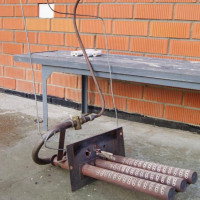 Homemade gas boiler for heating a private house and cottage: the manufacture of three proven designs
Homemade gas boiler for heating a private house and cottage: the manufacture of three proven designs 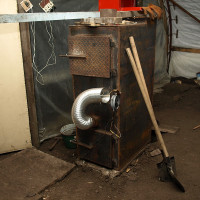 Do-it-yourself pyrolysis boiler: device, circuits, principle of operation
Do-it-yourself pyrolysis boiler: device, circuits, principle of operation  Do-it-yourself heating boiler piping: schemes for floor and wall boilers
Do-it-yourself heating boiler piping: schemes for floor and wall boilers  The heat accumulator for heating boilers: device, purpose + DIY manufacturing instructions
The heat accumulator for heating boilers: device, purpose + DIY manufacturing instructions 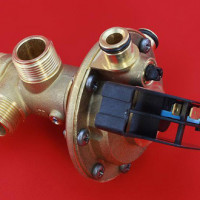 How to check a three-way valve in a gas boiler: DIY valve check instructions
How to check a three-way valve in a gas boiler: DIY valve check instructions  How much does it cost to connect gas to a private house: the price of organizing gas supply
How much does it cost to connect gas to a private house: the price of organizing gas supply  The best washing machines with dryer: model rating and customer tips
The best washing machines with dryer: model rating and customer tips  What is the color temperature of light and the nuances of choosing the temperature of the lamps to suit your needs
What is the color temperature of light and the nuances of choosing the temperature of the lamps to suit your needs  Replacement of a geyser in an apartment: replacement paperwork + basic norms and requirements
Replacement of a geyser in an apartment: replacement paperwork + basic norms and requirements
To be honest, the feasibility of self-assembly of an induction boiler looks dubious. The price will be slightly cheaper than the Chinese, and domestic ones. And the effectiveness of such homemade in the performance of an inexperienced person will be in question.
I agree. And it would be okay to doubt only the effectiveness, so the safety of such devices is a big question. I would be afraid to live next door to such a home-made induction heating boiler.